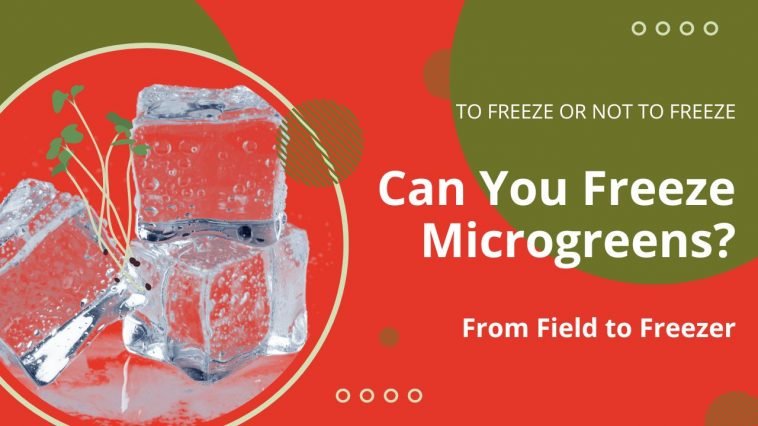Microgreens have short shelf life, many wonder if it’s possible to freeze microgreens to extend their usability. In this article, we will explore the feasibility of freezing microgreens, the benefits and drawbacks of this preservation method, effective freezing techniques, alternative preservation methods, and creative ways to use frozen microgreens.
Can you freeze microgreens?
Freezing is a common method of preserving various food items, but the suitability of freezing microgreens depends on several factors.
Texture and quality of microgreens:
Microgreens are known for their delicate textures and crispness. Freezing can cause changes in texture, resulting in a loss of the desirable crunch. However, certain microgreens with sturdier leaves and stems may withstand freezing better than others.
Read Here: 87 Types of Microgreens: A Comprehensive Microgreens List for Beginners
Nutritional value and flavor retention:
Microgreens are celebrated for their high nutritional content, including vitamins, minerals, and antioxidants. Freezing can lead to a slight loss of certain nutrients, but the overall nutritional value remains relatively intact. Flavor retention may vary depending on the type of microgreen and the freezing technique used.
Freezer compatibility and space availability:
Before freezing microgreens, it’s important to ensure that your freezer can maintain a consistently low temperature, ideally below 0°F (-18°C). Additionally, consider the availability of freezer space, as it may be limited.
Benefits and drawbacks of freezing microgreens:
Freezing microgreens offers certain benefits but also comes with a few drawbacks.
Benefits of freezing microgreens:
- Extended shelf life: Freezing microgreens can significantly prolong their usability, allowing you to enjoy them even during off-seasons.
- Convenience and accessibility: Frozen microgreens are readily available, making it easier to incorporate them into your daily meals and recipes.
- Year-round availability: By freezing microgreens, you can enjoy your favorite varieties regardless of seasonal constraints.
Drawbacks of freezing microgreens:
- Texture changes: Freezing can cause the delicate leaves and stems of microgreens to become limp or mushy, affecting their overall texture.
- Potential loss of nutritional value: While freezing minimally impacts the nutritional value of microgreens, certain nutrients may be slightly diminished.
- Flavor alterations: Some microgreens may experience a slight loss in flavor intensity or changes in taste after freezing.
How to freeze microgreens effectively:
To maximize the quality and usability of frozen microgreens, follow these steps:
Preparation and cleaning:
- Ensure the microgreens are fresh, vibrant, and free from any wilting or discoloration.
- Gently rinse them under cool water and pat them dry with a clean kitchen towel or paper towels.
Blanching or not?
- Blanching, a brief boiling followed by an immediate ice bath, can help preserve the color, texture, and flavor of certain microgreens. However, blanching is optional and may not be necessary for all varieties.
Packaging and storage tips:
- Place the clean and dry microgreens in airtight containers or freezer bags, removing as much air as possible.
- Label each container with the date of freezing to keep track of freshness.
- Store the containers in the coldest part of your freezer to maintain optimal freezing conditions.
Thawing and using frozen microgreens:
- When ready to use the frozen microgreens, remove the desired quantity from the freezer and thaw them in the refrigerator or at room temperature.
- Avoid refreezing thawed microgreens, as it can further impact their texture and quality.
- Incorporate the thawed microgreens into your recipes, such as smoothies, soups, salads, or as a garnish for various dishes.
Read Here: How to Store Microgreens after Harvest?
Alternative preservation methods for microgreens:
If freezing microgreens is not suitable for your needs, consider these alternative preservation methods:
Refrigeration:
- Microgreens can be stored in the refrigerator for a short period, usually up to a week.
- To maintain their freshness, place the microgreens in a container or a plastic bag lined with a damp paper towel and store them in the refrigerator’s crisper drawer.
Dehydrating:
- Dehydrating microgreens involves removing their moisture content, resulting in crispy and shelf-stable greens.
- Spread the cleaned and dried microgreens on a dehydrator tray or a baking sheet and set the temperature to low.
- Dehydrate until the microgreens are completely dry, and store them in airtight containers away from light and moisture.
Pickling or fermenting:
- Pickling or fermenting microgreens not only preserves their freshness but also imparts unique flavors.
- Prepare a brine or fermenting solution with vinegar, water, salt, and spices of your choice.
- Submerge the microgreens in the brine or fermenting solution and store them in sterilized jars in the refrigerator or at room temperature.
Recipes and creative ways to use frozen microgreens:
Frozen microgreens can be incorporated into various dishes, adding flavor, color, and nutrients. Here are a few creative ideas:
Smoothies and juices:
- Blend frozen microgreens with fruits, yogurt, and liquid of your choice to create nutritious and refreshing smoothies.
- Add frozen microgreens to homemade juices for an extra dose of vitamins and antioxidants.
Soups and stews:
- Toss frozen microgreens into soups or stews during the final stages of cooking to preserve their vibrant color and delicate flavors.
- Sprinkle thawed microgreens as a garnish on top of hot soups for an added pop of freshness.
Salads and sandwiches:
- Thawed microgreens can be used in salads as a nutritious base or mixed with other greens for added texture and flavor.
- Include thawed microgreens in sandwiches or wraps to elevate their taste and nutritional value.
Herb-infused oils and butters:
- Blend thawed microgreens with olive oil or melted butter to create herb-infused oils or flavored butters.
- Use these infused oils or butters to drizzle over cooked vegetables, pasta, or grilled meats for a burst of herbaceous goodness.
Read Here: Delicious Microgreens Recipes
Conclusion:
While freezing microgreens is possible, it’s important to consider the texture, nutritional value, and potential flavor alterations that may occur during the freezing process. Nevertheless, freezing remains a viable option for extending the shelf life of microgreens and ensuring year-round availability. If freezing is not suitable, alternative preservation methods such as refrigeration, dehydrating, pickling, or fermenting can also be explored. By exploring these techniques and incorporating frozen microgreens into various recipes, you can continue to enjoy the freshness, flavors, and health benefits of microgreens beyond their usual lifespan.



